The milk production in Argentina is based, minimally by a 70-80%, in the access to grazing lands with countless variants of supplementation of conserved forages and concentrated. The rest of the production would be based on conserved forages and concentrated with little or no participation from the grass. The seasonality in the pastoral systems supplemented argentine arises from the interaction between climate is temperate-humid, management, foraging, reproductive, and economy power. While the factors bioclimatic secure the basic shape of the curve (less in fall, maximum in spring), the decisions of calving, the level of supplementation, the infrastructure of well-being and the signal of prices determines how steep such a curve will be. The mitigation of the differential requires an integrated approach: the plan of forage reserves, diversifying dates of calving, invest in thermal comfort and implement commercial incentives that value the liter winter. Then we look at how the use of conserved forages, best use of winter crops and higher level of supplementation have improved the winter production attenuating the historical curve:
The following infographic summarizes an analysis a representative case of the local dairy farm production system in the last 10 years with pastoral system + supplementation, the production of spring marked the annual peak based on a maximum consumption of grass by the dairy herd (kg DMC/VO/day), explaining the seasonality by a 48% greater individual production and 52% for the largest number of cows milked:
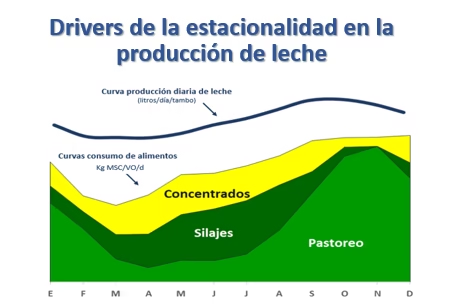
Analyzing the evolution of the same period but by the weather station we observe that the fall is still the period of lower volume of milk (1,0) and the spring is the period of greatest volume and the same proportionality relating to the production of autumn (With 1.25 and 1.25, we see that it maintains a +25% of volume on the fall for both the springs from 1980-1994 as for the current )
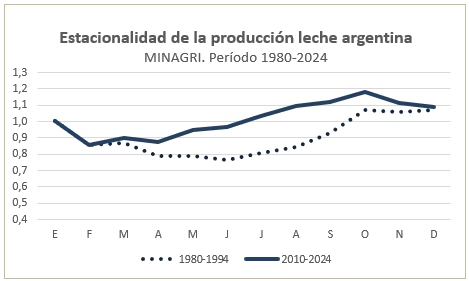
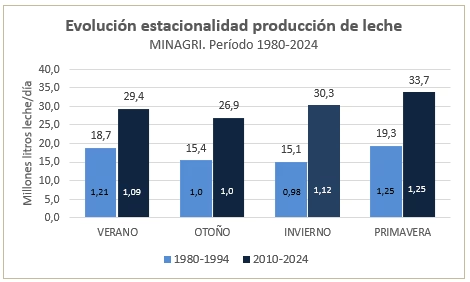
At the provincial level are observed Córdoba and Santa Fe have the same curvature, while Buenos Aires has the best fall and highest peak and markedly in October. The period observed are only 4 years, which prevents further comment and possibly affected by droughts recent. Remember that the availability of information on Watersheds reported by the SIGLEA is recent.
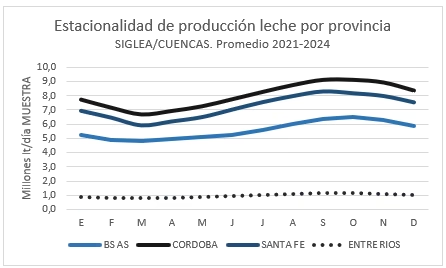
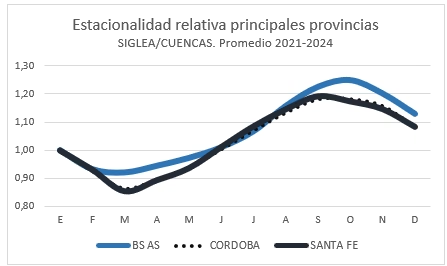
Production systems in Argentina are evolving significantly and may accelerate the stabilization of the economy and the financial offerings that should improve. It is interesting to compare the differences in the seasonality of the planets pastoral argentine with respect to the confined of the united States other than the rations totally blended (TMR) seasonality of births is more homogeneous and even manages the duration of the photoperiod with lighting in the barn:
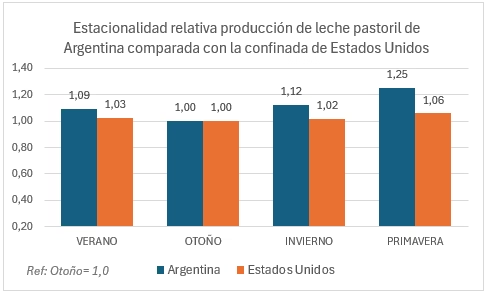


Very Good job, it is good to remember the behavior of the production in the year.
what possibilities you've Got to do a job where we compare the bodies of our country with Uruguay, Chile, NZ, to create a context of improvement throughout the dairy chain (solids of the Raw Material, logistics costs, and improvement in the transformation of the solid product.
Many Thanks
Thanks Flavio, compare with New Zealand would not bring much because they have a national model of cows crosses and Jersey high solids designed to survive in soil without agricultural capacity but a special climate for grass production. In a graph regional observe to Brazil 7,0 %HIS; Colombia 6,75 %HIS; Chile and 7.6% HIS; Uruguay 7,44% and Argentina with 7,17 %HIS. Could add to the united States with 7,52 %of HIS that I perceive as being most similar to the productive potential of Argentina.
Muy interesante trabajo Marcos! Tuve la posibilidad de trabajar en tambos estacionados en bs as de otoño como de primavera, y es muy interesante como el porcentaje de preñez cambia entre las 2 estaciones, se podría sumar esa variable al análisis, y comparar costos de producción!
Many thanks
Saludos
Me faltó agregar que En mis experiencias el porcentaje de preñes fue más alto en otoño en sistemas y vacas similares, y aún que no hubo un pico de producción muy marcado, la producción total de solidos de leche a lo largo del año terminan siendo similares entre las estaciones!